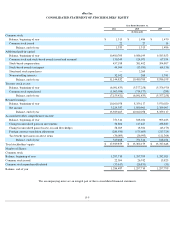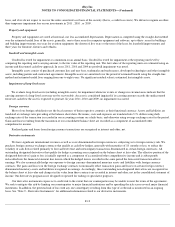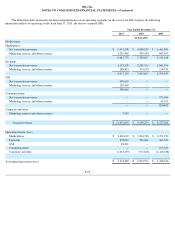eBay 2011 Annual Report Download - page 102
Download and view the complete annual report
Please find page 102 of the 2011 eBay annual report below. You can navigate through the pages in the report by either clicking on the pages listed below, or by using the keyword search tool below to find specific information within the annual report.
eBay Inc.
NOTES TO CONSOLIDATED FINANCIAL STATEMENTS—(Continued)
Allowance for loans and interest receivable
The allowance for loans and interest receivable represents management's estimate of probable losses inherent in our Bill Me Later portfolio.
The provision related to the principal is included in provision of transaction and loan losses and the provision related to the interest is recorded as
a reduction of marketing services and other revenue. The allowance for loans and interest receivable represents management's estimate of probable
losses inherent in our Bill Me Later portfolio which is considered to be of one segment and one class. Management's evaluation of probable losses
is subject to judgments and numerous estimates, including forecasted principal balance delinquency rates ("roll rates"). Roll rates are the
percentage of balances that we estimate will migrate from one stage of delinquency to the next based on our historical experience, as well as
external factors such as estimated bankruptcies and levels of unemployment. The roll rates are applied to principal and interest balances for each
stage of delinquency, from current to 180
days past due, in order to estimate the loans and interest that are probable to be charged off by the end of
180 days.
We charge off loans and interest receivable in the month in which the customer balance becomes 180 days past due. Bankrupt accounts are
charged off within 60 days of receiving notification of customer bankruptcy from the courts. Past due loans receivable continue to accrue interest
until such time as they are charged-off, with the portion of the reserve related to interest receivable balance classified as a reduction of revenue.
Funds receivable and funds payable
Funds receivable and funds payable relate primarily to our Payments segment and arise due to the time to clear transactions through external
payment networks. When customers fund their account using their bank account or credit card, or withdraw money to their bank account or
through a debit card transaction, there is a clearing period before the cash is received or settled, usually one to three business days for
U.S. transactions, and generally up to five business days for international transactions. To a lesser extent and primarily related to our Marketplaces
segment, we generate funds receivable in certain foreign locations from external credit providers that settle within 12 months ( $203.0 million and
$132.0 million as of December 31, 2011 and 2010, respectively).
Customer accounts
Based on differences in regulatory requirements and commercial law in the jurisdictions where PayPal operates, PayPal holds customer
balances either as direct claims against PayPal or as an agent or custodian on behalf of PayPal's customers. Customer balances held as direct
claims against PayPal are included on our consolidated balance sheet as funds receivable and customer accounts with an offsetting current liability
in funds payable and amounts due to customers. We maintain these customer account balances in interest bearing bank deposits, including time
deposits with maturity dates of less than one year. Customer funds held by PayPal as an agent or custodian on behalf of our customers are not
reflected in our consolidated balance sheet. These off-balance sheet funds include funds held in the U.S. that are deposited in bank accounts
insured by the Federal Deposit Insurance Corporation (subject to applicable limits).
Investments
Short-term investments, which include marketable equity securities, time deposits and government and corporate bonds with original
maturities of greater than three months but less than one year when purchased, are classified as available-for-sale and are reported at fair value
using the specific identification method. Unrealized gains and losses are excluded from earnings and reported as a component of other
comprehensive income (loss), net of related estimated tax provisions or benefits.
Long-term investments include government and corporate bonds, time deposits and cost and equity method investments. Debt securities are
classified as available-for-sale and are reported at fair value using the specific identification method. Unrealized gains and losses are excluded
from earnings and reported as a component of other comprehensive income (loss), net of related estimated tax provisions or benefits.
Time deposits are classified as held to maturity and recorded at amortized cost. Our equity method investments are investments in privately
held companies. In certain circumstances, investments include goodwill. Our consolidated results of operations include, as a component of interest
and other, net, our share of the net income or loss of the equity method investments. Our share of investees' results of operations is not significant
for any period presented. Our cost method investments consist of investments in privately held companies and are recorded at cost. Amounts
received from our cost method investees were not material to any period presented.
We assess whether an other-than-temporary impairment loss on our investments has occurred due to declines in fair value or other market
conditions. With respect to our debt securities, this assessment takes into account our intent to sell the security, whether it is more likely than not
that we will be required to sell the security before recovery of its amortized cost
F-11
























